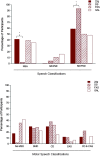Estimates of the Prevalence of Speech and Motor Speech Disorders in Youth With 22q11.2 Deletion Syndrome
- PMID: 30515510
- PMCID: PMC6503865
- DOI: 10.1044/2018_AJSLP-18-0037
Estimates of the Prevalence of Speech and Motor Speech Disorders in Youth With 22q11.2 Deletion Syndrome
Abstract
Purpose Speech sound disorders and velopharyngeal dysfunction are frequent features of 22q11.2 deletion syndrome (22q). We report the first estimate of the prevalence of motor speech disorders (MSDs) in youth with 22q. Method Seventeen children and adolescents with 22q completed an assessment protocol that included a conversational speech sample. Data reduction included phonetic transcription, perceptual speech ratings, prosody-voice coding, and acoustic analyses. Data analyses included 3 motor speech measures and a cross-classification analytic. Prevalence estimates of speech and MSDs in youth with 22q were compared with estimates in speakers with other complex neurodevelopmental disorders: Down syndrome, fragile X syndrome, and galactosemia. Results Results indicated that 58.8% of the participants with 22q met criteria for speech delay, and 82.4% of the participants met criteria for MSDs, including 29.4% with speech motor delay, 29.4% with childhood dysarthria, 11.8% with childhood apraxia of speech, and 11.8% with concurrent childhood dysarthria and childhood apraxia of speech. MSDs were not significantly associated with velopharyngeal dysfunction. Conclusions In summary, 82.4% of the participants with 22q met criteria for 1 of 4 MSDs, predominantly speech motor delay and childhood dysarthria. Cross-validation of the present findings would support viewing MSDs as a core phenotypic feature of 22q.
Figures




Similar articles
-
Estimates of the prevalence of speech and motor speech disorders in persons with complex neurodevelopmental disorders.Clin Linguist Phon. 2019;33(8):707-736. doi: 10.1080/02699206.2019.1595732. Clin Linguist Phon. 2019. PMID: 31221012 Free PMC article.
-
Estimates of the prevalence of speech and motor speech disorders in adolescents with Down syndrome.Clin Linguist Phon. 2019;33(8):772-789. doi: 10.1080/02699206.2019.1595735. Clin Linguist Phon. 2019. PMID: 31221009 Free PMC article.
-
Estimates of the prevalence of motor speech disorders in children with idiopathic speech delay.Clin Linguist Phon. 2019;33(8):679-706. doi: 10.1080/02699206.2019.1595731. Epub 2019 Apr 15. Clin Linguist Phon. 2019. PMID: 30987467 Free PMC article.
-
A Tool for Differential Diagnosis of Childhood Apraxia of Speech and Dysarthria in Children: A Tutorial.Lang Speech Hear Serv Sch. 2022 Oct 6;53(4):926-946. doi: 10.1044/2022_LSHSS-21-00164. Epub 2022 May 6. Lang Speech Hear Serv Sch. 2022. PMID: 35523425 Review.
-
Screening for speech and language delay: a systematic review of the literature.Health Technol Assess. 1998;2(9):1-184. Health Technol Assess. 1998. PMID: 9728296 No abstract available.
Cited by
-
Disrupted Coordination of Hypoglossal Motor Control in a Mouse Model of Pediatric Dysphagia in DiGeorge/22q11.2 Deletion Syndrome.eNeuro. 2020 Oct 9;7(5):ENEURO.0520-19.2020. doi: 10.1523/ENEURO.0520-19.2020. Print 2020 Sep/Oct. eNeuro. 2020. PMID: 32855199 Free PMC article.
-
Speech-Language Disorders in 22q11.2 Deletion Syndrome: Best Practices for Diagnosis and Management.Am J Speech Lang Pathol. 2019 Aug 9;28(3):984-999. doi: 10.1044/2019_AJSLP-16-0147. Epub 2019 Jul 22. Am J Speech Lang Pathol. 2019. PMID: 31330115 Free PMC article. Review.
-
Development of Speech and Communication in Polish Children with 22q11.2 Deletion Syndrome: A Cross-Sectional Study.Brain Sci. 2024 Dec 29;15(1):24. doi: 10.3390/brainsci15010024. Brain Sci. 2024. PMID: 39851392 Free PMC article.
-
Comorbidity and Severity in Childhood Apraxia of Speech: A Retrospective Chart Review.J Speech Lang Hear Res. 2023 Mar 7;66(3):791-803. doi: 10.1044/2022_JSLHR-22-00436. Epub 2023 Feb 16. J Speech Lang Hear Res. 2023. PMID: 36795544 Free PMC article.
-
Impact of Equine-Assisted Interventions on Heart Rate Variability in Two Participants with 22q11.2 Deletion Syndrome: A Pilot Study.Children (Basel). 2021 Nov 22;8(11):1073. doi: 10.3390/children8111073. Children (Basel). 2021. PMID: 34828786 Free PMC article.
References
-
- Abbeduto L., Murphy M. M., Cawthon S. W., Richmond E. K., Weissman M. D., Karadottir S., & O'Brien A. (2003). Receptive language skills of adolescents and young adults with Down or fragile X syndrome. American Journal on Mental Retardation, 108, 149–160. - PubMed
-
- American Speech-Language-Hearing Association. (2007). Childhood apraxia of speech [Technical report]. Retrieved from http://www.asha.org/public/speech/disorders/ChildhoodApraxia/
-
- Bales A. M., Zaleski C. A., & McPherson E. W. (2010). Newborn screening programs: Should 22q11 deletion syndrome be added? Genetics in Medicine, 12, 135–144. - PubMed
-
- Barnea-Goraly N., Eliez S., Menon V., Bammer R., & Reiss A. L. (2005). Arithmetic ability and parietal alterations: A diffusion tensor imaging study in velocardiofacial syndrome. Cognitive Brain Research, 25, 735–740. - PubMed
-
- Barnea-Goraly N., Menon V., Krasnow B., Ko A., Reiss A., & Eliez S. (2003). Investigation of white matter structure in velocardiofacial syndrome: A diffusion tensor imaging study. American Journal of Psychiatry, 160, 1863–1869. - PubMed
Publication types
MeSH terms
Grants and funding
LinkOut - more resources
Full Text Sources
Medical
Miscellaneous

